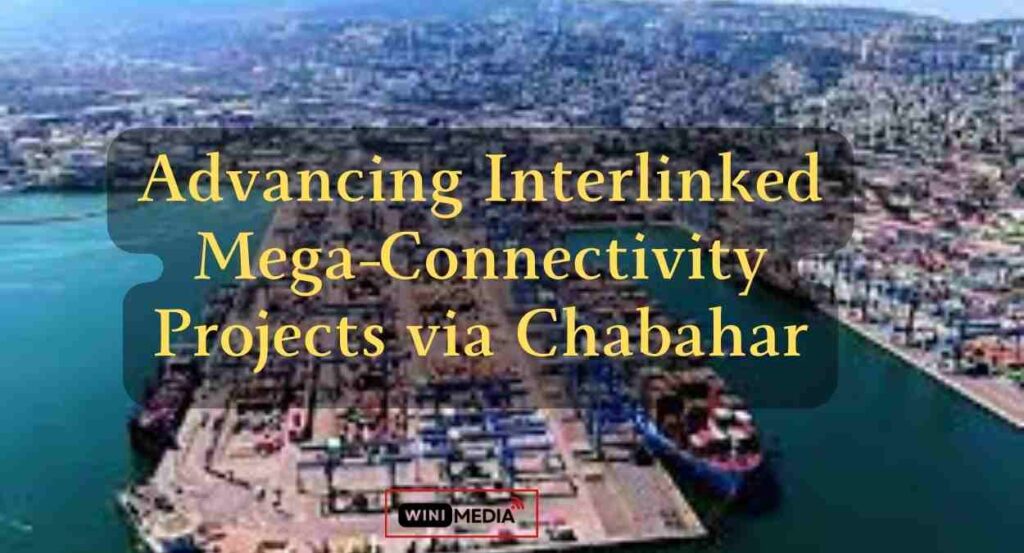{Chabahar Port, India Iran agreement, trade route central asia, eam jaishankar iran visit, india afghanistan connectivity, maritime gateway middle east, counter china pakistan corridor}

India Unlocks Gateways to Eurasia: $8 Bn Chabahar Port Deal Inked with Iran
After almost two decades of geopolitical machinations and realignments, India has finally clinched a long-term agreement with Iran to develop the strategic Chabahar port. This critical connectivity project, conceived first in 2003, will operationally link India with Iran, Afghanistan and wider Central Asia by establishing a vital transit corridor bypassing Pakistan.
Located in Sistan-Balochistan province along Iran’s southeastern coast, the Chabahar port provides India its first overseas port project and a pivotal anchor point for greater regional integration westwards. The deal was sealed during External Affairs Minister Dr S. Jaishankar’s January 2024 visit to Tehran, where he met newly elected Iranian President Ebrahim Raisi, Foreign Minister Hossein Amirabdollahian, Roads Minister Rostam Ghasemi among other key stakeholders.
Why Chabahar Port Matters Greatly for India
For India, the strategic value of developing Chabahar port can hardly be overstated. It catalyzes multiple facets of India’s regional policy priorities:
- Access Afghanistan Bypassing Pakistan: Provides India direct access to Afghanistan circumventing the Pakistan route, facilitating increased humanitarian assistance and bilateral trade.
- Gateway to Central Asia & Eurasia: Allows efficient connectivity to landlocked Central Asian republics, Eurasian Russian markets as well as Europe via International North-South Transport Corridor (INSTC).
- Energy Security: Links India with Iran and CAR energy reserves as well as global gas transit routes like the TAPI pipeline. Circumvents China’s dominance in overseas oil/gas assets via BRI-related control.
- Counter Gwadar Port & BRI Encroachment: Strategic counterweight to neutralize China’s expanding footprint via Gwadar Port in Pakistan and wider BRI-linked digital and economic inroads across the Middle East.
- Regional Integration & Chokehold Release: Afghanistan, despite vast mineral riches. Enables economic growth for landlocked Afghanistan and CAR nations by facilitating trade flows. Loosens geostrategic chokehold due to lack of warm water access or alternative routes held by Pakistan & China.
- Soft Power Projection: Showcases India’s constructive development partnership and benign power credentials by enabling positive-sum growth for all regional stakeholders, unlike China’s opaque debt-trap diplomacy.
This multi-layered policy significance makes Chabahar port what former Indian Diplomat, Amb. Pinak Chakravarty calls it “a lynchpin in the architecture of regional connectivity” for India across West and Central Asia. Leveraging Chabahar, India seeks to shape an extended neighbourhood where New Delhi’s inclusive leadership and Tehran’s regional influence synergize to balance destabilizing waves triggered by the BRI expansionist surge.

Genesis of Chabahar Port Project Tied to India’s Eurasian Aspirations
The origins of the Chabahar port connectivity project as a linchpin for India to access Central Asia and Eurasian markets date back almost seventeen years.
Seeding a Strategic Partnership: 2003 Onwards
- In 2003, when previous Iranian President Mohammed Khatami visited India, the two regional heavyweights resolved to collaborate on developing Chabahar – seen increasingly as a counterfoil to the Chinese-funded Gwadar port in Pakistan.
- The proposal gained momentum in 2016 when Prime Minister Modi signed a trilateral pact with Iranian President Rouhani and Afghan President Ashraf Ghani to transform Chabahar into a transit hub linking SAARC with Central Asia, Russia and eventually Europe.
Temporary Derailment Amid US Sanctions: 2017-2020
- Progress slowed however as the Trump administration unilaterally canceled the Obama-led 2015 Iran nuclear deal in 2017 and reimposed crippling sanctions on Tehran
- India had to reluctantly restrict oil imports and freeze involvement in Chabahar development to safeguard relations with Washington and mitigate the CAATSA sanctions risk
- Beijing exploited this vacuum by deepening economic ties and finalizing a 25-year strategic partnership with Tehran in 2021, raising eyebrows in Delhi.
Renewed Diplomatic Overtures by Modi 2.0: 2021 Onwards
- Following the Biden presidency’s return to the multilateral Iran nuclear agreement, India ramped up outreach with Iran
- In Uzbekistan CONNECT 2022, EAM Jaishankar pitched Cha bahar’s role in the International North-South Transport Corridor (INSTC)
- This set the stage for the January 2024 EAM visit consummating the Chabahar port development deal with Tehran

Unpacking The Signed India-Iran Deal On Chabahar Port
Having traced the geopolitical chronology leading India to this Chabahar deal with Iran, let’s examine the key aspects of the agreed framework:
Strategic Signposts of The Deal
- In principle, approval was secured for Indian firms to develop Shahid Beheshti port at Chabahar on a 10-year lease
- Plan to establish direct India-Iran shipping line boosting bilateral trade potential discussed
- Exploration of a detailed & binding 25-year contract for the long-term Indian operation of Chabahar port
- Intent declared to conclude previous $85 million infrastructure contract offered by India
- Proposed formation of shipping line to kickstart freight trade via Chabahar to CAR and Eurasia
- Possibility of a Joint Technical Committee for smooth cross-country coordination
Associated Regional Connectivity Projects
- Progressing the multimodal INSTC corridor to link India with Central Asia and Europe via Iran
- Studying the feasibility of the India-Uzbekistan-Iran connectivity corridor to facilitate Eurasian transit
- Transit access to Afghanistan for humanitarian aid and energy imports from the CAR region
The fine print is still being drafted during ongoing technical consultations between both governments.
But Delhi’s high-octane diplomatic push has already worked to regain Tehran’s confidence in India’s strategic commitment to regional connectivity despite erratic global headwinds beyond her control.

Advancing Interlinked Mega-Connectivity Projects via Chabahar
As mentioned earlier, India’s developmental priorities with regard to Chabahar extend beyond the port to imagine interlinked connectivity corridors spanning the arc from South Asia to Central Asia and Europe.
Two key mega-projects tied to the Chabahar gateway are:
International North-South Transport Corridor (INSTC)
Envisaged as a 7200 km long multimodal connectivity network linking India with Russia and Europe via the Middle East, INSTC has been in the works since 2000 with Russia, India and Iran as founding members.
The plan envisions integrated sea, rail and land routes enabling freight movement from St. Petersburg to industrial zones in western India like Mumbai and vice-versa.
- Dry runs have validated operationalization capacity, maritime shipping lines are being augmented and the customs framework is being synchronized.
Benefits of INSTC Corridor
- Alternative transport route compared to traditional Suez passage – lowers costs & distances
- Opportunity to tap consumer markets in Eurasia, especially for Indian exports
- Enables economies of landlocked Central Asia and Eurasia by easing market access
- Locks India firmly within emerging Eurasian geo-economic architecture
With the Chabahar link now greenlit, INSTC has cleared a major infrastructural bottleneck – setting the stage for functional commencement ahead.
India-Middle East-Europe (IMEC) Corridor
This ambitious connectivity corridor plans to link India with Eurasian markets by developing an India-Iran-Uzbekistan axis.
- Conceived on the sidelines of the 2022 CONNECT summit, India has floated a detailed blueprint for cooperation seeking to merge the INSTC vision with Trans-Caspian East-West trade flows.
- The proposed IMEC multimodal corridor would commence from Mumbai linking Uzbekistan’s capital Tashkent eventually extending northwards to Kazakhstan, Turkmenistan and even leading further to Europe.
Chabahar forms the Iranian junction allowing Indian cargo and exports to make the Arabian Sea to Caspian Sea transition before traversing Central Asia upwards. Successful operationalization can transform Eurasia’s economic landscape.

Strategic Advantage for India as Counterweight to China’s BRI
The Chabahar deal, despite still being in its infancy, shores up India’s regional stature both intrinsically by building national capacity and indirectly by reigning in China’s unchecked overseas infrastructure expansionism in neighbouring geographies. Specifically, it balances against three BRI dimensions:
1. Counter-Cube to Gwadar Port in Pakistan
Pakistan’s Chinese-operated Gwadar port barely 100 km from Chabahar has emerged as a BRI showcase, deepening Islamabad’s economic dependence. Like Dubai’s Jebel Ali, Gwadar’s planned transformation into a shipping and finance hub worried Delhi about spillover security risks.
Indian control over Chabahar directly counterbalances Gwadar’s strategic footprint. Further extensions like the proposed Iran-India gas pipeline also curb Beijing’s pre-dominance over regional energy flows especially from the Caspian basin and Central Asia where China has been acquiring assets.
2. Offer Asian Nations A Non-Predatory Development Model
Several South Asian and Central Asian middle powers like Sri Lanka, Myanmar, and Kyrgyzstan once drawn by BRI’s shiny promise have realized the pitfalls of Chinese debt, dependency and erosion of sovereign leverage.
As Askar Akaev, ex-President of Kyrgyzstan notes, “Once you become dependent, you cease to be a sovereign state”. Chabahar’s co-development allows India to showcase her collaborative capacities and credentials as a responsible development partner respecting national agency – unlike China’s ‘debt trap diplomacy’.
3. Catalyze India’s Centrality in Regional Integration
Chabahar fuels the ongoing shift in strategic gravitation of Central Asia and Eurasia away from the Russia-China regional dyad towards a Russia-India-Iran triangular dynamic that prevents dominance of any one external extraterritorial power.
India utilizing Chabahar and INSTC to transcreate a niche as the regional energy, connectivity and economic integrator creating interdependence can shape a sphere of influence balancing the Chinese juggernaut.
Deeper trade corridors would also allow India to imbibe best practices by leveraging the advanced expertise of northern industrial powers like Germany to bolster her manufacturing base through co-development.
In turn, India exports technical services, digital tools and hemispheric leadership to developing Southern nations – crafting true multi-directional collective gain.
Watch the Web Story on How India Unlocks Eurasia Gateway through Chabahar Port?:
FAQs About India and Chabahar Port Agreement
Q1. Where is the Chabahar port located?
The Chabahar port is located in southeastern Iran, on the Gulf of Oman.
Q2. Why is India developing the Chabahar port?
India is developing Chabahar port to establish a transit route for trade/access to Afghanistan and Central Asia, bypassing Pakistan.
Q3. What connectivity corridors will intersect at Chabahar?
The International North-South Transport Corridor (INSTC) and the proposed India-Middle East-Europe Economic Corridor (IMEC) will intersect at Chabahar port.
Q4. How will Chabahar port project help counter China’s BRI?
Chabahar boosts India’s regional connectivity outreach and provides an alternative route diminishing dependence on China-sponsored BRI corridors in the Middle East.
Q5. Who originally proposed the Chabahar port project?
The port development was first proposed in 2003. After several rounds of negotiation, India and Iran signed the original agreement in 2016.
Q6. Has Pakistan attempted to undermine the project?
Yes, Pakistan has viewed this strategic Indian infrastructure project near its borders with suspicion and likely attempted to delay it.
Q7. When is the Chabahar expected to be operational?
After the latest 2023 agreement, the timeline for completion of the port infrastructure and the start of operations is presently unclear but expected in the next few years.
Final Word
In sum, while analytical observers may critique India’s execution delays that allowed China a first-mover advantage in entering Iran from 1997 onwards, Delhi remains relentless in playing the long game about Chabahar port.
What matters ultimately is that India stuck to her strategic convictions bipartisansly across multiple governments.
With new winds in the Iran-US relationship enabling conducive conditions for India to re-engage with Iran, Pakistan would serve itself well by taking notes on how vision plus perseverance converts goodwill into tangible outcomes.
Reinforcing the Indian foothold along Iran’s strategic Makran coast through Chabahar while meticulously tying it together via inland trade networks ultimately fulfils the regional connectivity promise envisaged when Narendra Modi began his premiership in 2014.
It validates India’s destiny as the inheritor of the Persianate legacy steering an emerging multipolar constellation where civilizational pragmatism wins over coercive ideological agendas – heralding the Asian century with New Delhi at its core.
Key Details of The New India-Iran Pact on Chabahar Port
The key highlights of the finalized deal on Chabahar port between India and Iran are:
- India will develop and operate one of the two ports named Shahid Beheshti Port
- Plan to establish a shipping line between the two countries to boost trade
- Exploration of a long-term contract for Indian management of the port operations
- Setting up a joint technical committee for smooth cooperation on connectivity projects
- Commitment to finalize USD 85 million infrastructure contract offered by India
Disclaimer:
This blog post on the India-Iran Chabahar Port agreement is for informational purposes only. For official or legal queries, please refer to appropriate sources. The blog Wini Media does not bear any liability for decisions made based on this post.
Also Read:
D2M Technology: India’s Upcoming SIM-Free Broadcasting Service
Axiom-3: Launching the First All-European Private Crew to the ISS
Is Ambani’s Empire Burning Down After Massive 56% Profit Wipeout?: Jio Financial Services Q3 Results
NASA Sends Out Warning : Aircraft-Sized Asteroid Hurtles Towards Earth At Frightening Speeds.
What Does The Odometer Of An Automobile Measure? Your Car’s Odometer Reading Explained
The Complete Guide to Transformational Vipassana Meditation
The Truth About the Global Vipassana Pagoda’s Mesmerizing Relics































